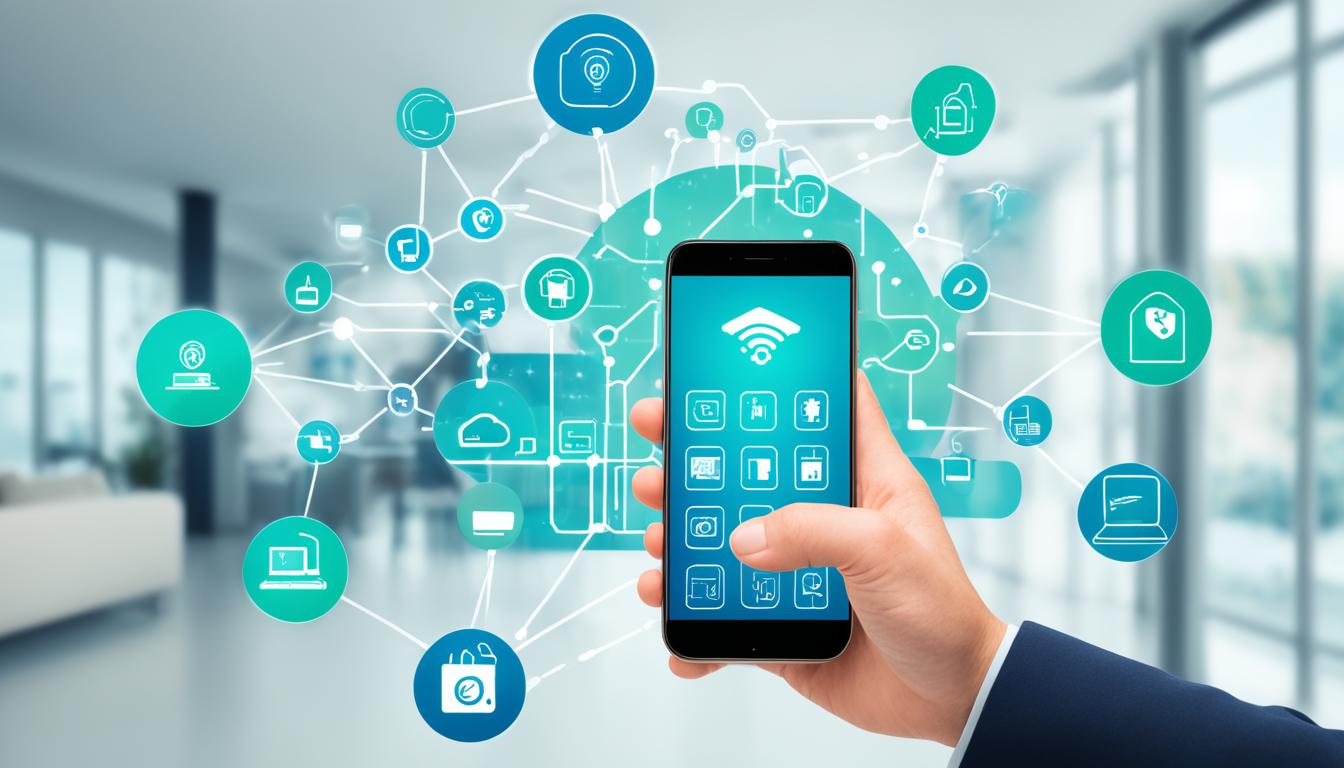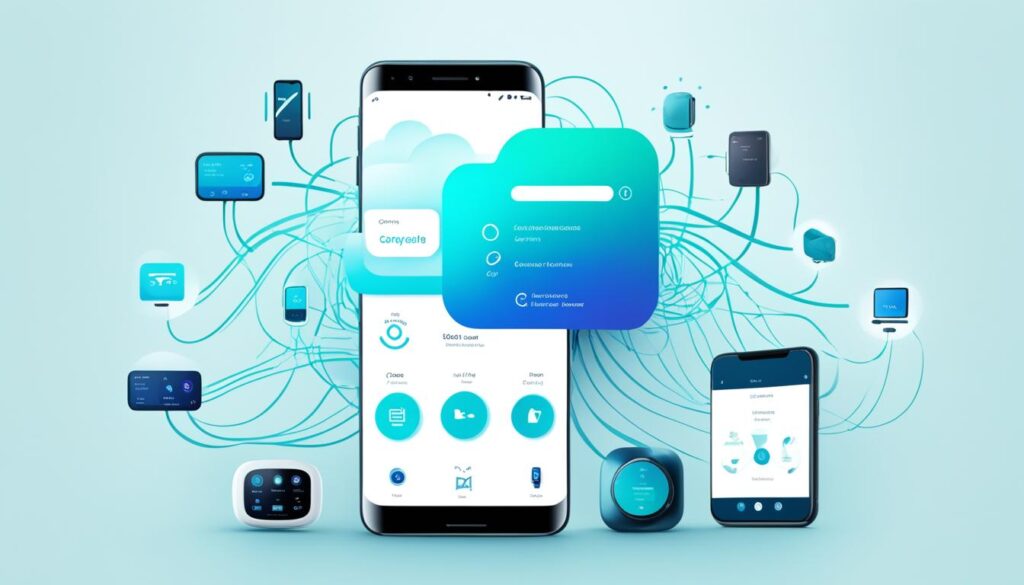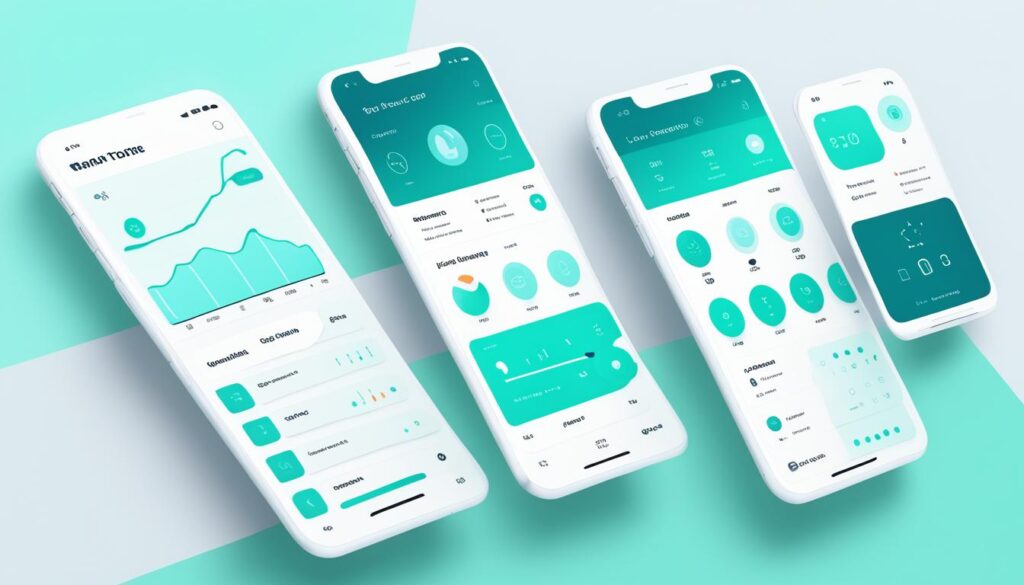The Internet of Things (IoT) is changing how we interact with the world. It’s making smart devices more common, and we need apps that work well with them. This guide will show you how to make apps that connect smart devices. These apps make our lives better by giving us new ways to use data.
Building IoT apps is exciting and fast-changing. It’s all about connecting devices and giving people real-time data. These apps manage and control smart devices, from home gadgets to industrial equipment. They help people and businesses use the power of connected devices.
Table of Contents
Key Takeaways
- Explore the fundamental concepts of IoT mobile app development and its importance in the connected world.
- Understand the key considerations when building IoT mobile apps, including platform selection, user interface design, and device integration.
- Discover strategies for ensuring data security and user privacy in IoT mobile applications.
- Learn about the best practices and tools for testing, deploying, and maintaining IoT mobile apps for smart devices.
- Gain insights into the future trends and emerging technologies shaping the IoT mobile app landscape.
Introduction to IoT Mobile App Development
In today’s world, IoT (Internet of Things) mobile apps are key to the smart device world. They let users easily control and check their connected devices. This includes everything from smart home gadgets to wearable tech.
What are IoT Mobile Apps?
IoT mobile apps work with IoT devices to give users a simple way to manage their smart devices. You can put these apps on phones, tablets, or other devices. They make it easy to use and control IoT systems, like home automation or industrial monitoring.
The Importance of IoT Mobile Apps in a Connected World
As more people use IoT tech, IoT mobile apps become more vital. They are key in the IoT world. They let users:
- Control and check their smart home devices, like lights, temperature, and security systems from afar
- Use wearable tech, like fitness trackers and smartwatches, to keep an eye on health and activity
- Work with industrial IoT systems for better monitoring and improving industrial processes
- Link different IoT devices together for a smooth and responsive connected world
These apps offer a user-friendly way to handle their IoT mobile apps, connected devices, and smart home apps. They’re essential in the age of wearable technology and the mobile app for IoT.
Key Considerations for Building IoT Mobile Apps
Creating IoT mobile apps needs a lot of thought. Developers must think about IoT app development and handle device connectivity, data management, power consumption, and device integration.
Getting devices to talk to each other is key for IoT apps. Developers must plan for connectivity using Wi-Fi, Bluetooth, and cellular networks. This ensures a smooth experience for users.
Handling data management well is also crucial. Developers need to make systems that can handle lots of data from devices. They must think about secure data storage, real-time analytics, and keeping data in sync.
IoT apps also need to be efficient with power. Mobile devices and IoT hardware can’t use too much power or the battery will run out fast. Developers use methods like duty cycling and smart power management to save power.
Finally, making sure devices work well together is key. Developers aim to make apps that can easily connect with many IoT devices and smart appliances. This gives users a smooth and easy experience.
| Consideration | Description |
|---|---|
| Connectivity | Ensuring reliable communication between mobile devices and IoT hardware across various network protocols. |
| Data Management | Designing robust systems for collecting, processing, and storing the vast amounts of data generated by connected devices. |
| Power Consumption | Optimizing power consumption through techniques like duty cycling, sensor data caching, and intelligent power management. |
| Device Integration | Enabling seamless connection, control, and management of a diverse range of IoT devices, sensors, and smart home appliances. |
By focusing on these key areas, developers can make IoT mobile apps that work well and are easy to use. This unlocks the full potential of the connected world.
Choosing the Right IoT Platform
The world is getting more connected, making the need for strong IoT platforms for mobile apps grow. Picking the right platform is key to your project’s success. You have many options, from open-source to cloud-based IoT platforms, each with special features.
Popular IoT Platforms for Mobile App Development
Top IoT platforms for mobile app development include AWS IoT, Google Cloud IoT, and Microsoft Azure IoT. They offer everything you need to connect devices, manage data, and build big IoT apps. You’ll find features like device management, data analytics, and secure communication.
Factors to Consider When Selecting an IoT Platform
When picking an IoT platform for your app, think about these important things:
- Platform Maturity and Ecosystem: Check how stable the platform is, its community support, and the tools and integrations it has.
- Scalability and Reliability: Make sure the platform can grow with your IoT system and always works well.
- Security and Privacy: Choose platforms that keep your users and their data safe.
- Ease of Integration: Look for a platform that fits well with your systems and is easy to add to your app development.
- Cost and Pricing Structure: Look at the platform’s pricing, including any extra fees or charges, to make sure it fits your budget and needs.
By looking at these factors, you can pick the best IoT platform for your mobile app development needs. This leads to a successful and lasting IoT ecosystem.
Designing User-Friendly IoT Mobile App Interfaces
The Internet of Things (IoT) is changing how we use our connected devices. Designing IoT mobile app interfaces is now more important than ever. It’s all about making user experiences smooth and engaging. This ensures a good connection between users and their IoT devices.
Best Practices for IoT Mobile App UI/UX Design
Creating user-friendly IoT mobile apps means understanding their unique challenges. Here are some tips to remember:
- Responsive Design: IoT apps need to work well on different screens and devices. This ensures a great experience everywhere.
- Simplicity and Clarity: Make apps simple and clean. This lets users easily use and control their devices.
- Seamless Integration: Apps should work well with the devices they manage. This makes using smart devices natural and easy.
- Personalization and Customization: Let users make their apps their own. This meets their personal needs and likes.
- Intuitive Navigation: Make it easy to navigate through apps. Clear and logical layouts help users find what they need fast.
Using these tips, developers can make IoT apps that improve the user experience. This leads to more engagement and happiness from users.
“Designing intuitive and responsive IoT mobile app interfaces is crucial for driving user adoption and ensuring a seamless connected experience.”
Integrating IoT Devices with Mobile Apps
The Internet of Things (IoT) is changing how we interact with our world. Integrating IoT devices with mobile apps is key to this change. This connection lets users control and monitor their devices from smartphones or tablets. It makes things easier and more efficient.
At the core, device discovery and connectivity are vital. Mobile apps must find and connect to IoT devices easily. They use Bluetooth, Wi-Fi, or cellular networks for secure communication.
After connecting, bi-directional communication lets users send commands and get updates. This means they can control devices from their phones. It’s important for a good IoT experience, like changing settings or checking energy use.
For smooth data synchronization, developers need strong data management. They keep device status and data up-to-date in real-time. This gives users a clear view of their IoT devices, helping them make better decisions.
By getting good at IoT device integration, mobile app developers can create amazing experiences. They can use connected devices in new and helpful ways. As IoT grows, being able to connect mobile apps with devices well will set businesses and developers apart.
Data Security and Privacy in IoT Mobile Apps
The Internet of Things (IoT) is growing fast, making mobile apps key to a world of smart devices. These apps handle sensitive data and control many systems. It’s vital to keep them secure and protect user privacy. Developers must focus on strong security and data privacy.
Implementing Robust Security Measures
For secure IoT mobile apps, a multi-layered security approach is needed. This means encrypting data and using strong authentication and access controls. The latest encryption and authentication can lower the risk of unauthorized access and data theft.
Ensuring User Privacy and Data Protection
Keeping user privacy safe is key in making IoT mobile apps. Developers must follow rules like GDPR and HIPAA for handling user data right. Being open about how data is used and giving users control over their info builds trust and keeps privacy safe.
| Security Measure | Description |
|---|---|
| Encryption | Using top encryption to protect data at rest and in transit |
| Authentication | Strong ways to check if a user is who they say, like biometrics or more than one way to prove it |
| Access Control | Setting up strict access rules to limit what users can do and see |
| Regulatory Compliance | Following rules like GDPR and HIPAA to keep user data safe |
By focusing on IoT mobile app security and data privacy, developers can make trusted apps. These apps keep user info safe and follow the rules.
Building IoT Mobile Apps for Smart Devices
The Internet of Things (IoT) is changing how we interact with our world. Developing IoT mobile apps is key to this change. These apps connect users with their smart devices, from IoT app development for smart homes to wearables and industrial IoT tools.
Creating apps for smart devices means understanding the mobile app architecture for IoT. Apps must fit the needs of devices like smart home gadgets, fitness trackers, or industrial gear. We must think about what these devices can do, how they handle data, and how users will interact with them.
One big challenge is making sure the app and devices work well together. This means setting up secure ways for them to talk to each other, handling device data, and making interfaces that are easy for users to use.
| IoT Device Category | Key Considerations for Mobile App Development |
|---|---|
| Smart Homes |
|
| Wearables |
|
| Industrial IoT |
|
By tackling these challenges, developers can make IoT mobile apps for smart devices that offer great user experiences. These apps improve efficiency and bring out the best in the connected world.
Testing and Debugging IoT Mobile Apps
Creating strong and dependable IoT mobile apps needs a careful testing and debugging process. It’s important to make sure IoT devices work well together, connect to the network, and handle data correctly. We’ll look at the main ways to test and fix IoT mobile apps in this section.
Strategies for Effective Testing and Debugging
A thorough testing strategy is key for high-quality IoT mobile apps. It covers checking how IoT devices work together, network connections, data handling, and unusual situations. Using automation tools for testing can make the process faster and more efficient.
Debugging IoT apps can be tough because problems can happen where the app, devices, and networks meet. Special debugging tools for IoT can help find and fix these issues. This way, developers can give users a smooth experience.
| Testing Approach | Key Focus Areas |
|---|---|
| IoT Integration Testing |
|
| Network Connectivity Testing |
|
| QA for IoT |
|
By following these best practices for testing and debugging IoT mobile apps, developers can make sure their apps work well and give users a great experience. This will help make IoT technology more popular.
Deploying and Maintaining IoT Mobile Apps
In the fast-changing world of the Internet of Things (IoT), getting IoT mobile apps out there and keeping them running smoothly is key. From IoT mobile app deployment to keeping them updated, we’ll cover what you need to know to manage your IoT mobile app’s life cycle well.
Deployment Strategies for IoT Mobile Apps
When it comes to deploying IoT mobile apps, planning is everything. Here are some top strategies:
- Over-the-air (OTA) updates: Over-the-air updates make it easy to keep the app fresh with new features and fixes without needing to physically touch the devices.
- Remote device management: This lets developers and IT teams manage and fix IoT devices from anywhere, reducing the need for in-person visits.
- Staged rollouts: This method tests the app on a small group first, helping spot and fix problems before it goes wider.
Ongoing Maintenance and Updates
Keeping IoT mobile apps running well is a constant job. Here’s what’s involved in app lifecycle management:
- Regular updates to fix bugs, improve security, and add new features
- Checking how devices and users like the app to find ways to get better
- Keeping up with the latest operating systems and device updates
- Offering good customer support to solve user problems quickly
With strong deployment plans and a focus on IoT app development, companies can make sure their IoT apps work well for a long time. This makes users happier and helps more people use their smart devices.
IoT Mobile App Development Tools and Resources
The IoT mobile app development scene is changing fast. Developers have many tools and resources to make their work easier. From IoT mobile app development tools to cloud-based IoT platforms and open-source IoT frameworks, there are lots of options. We’ll look at some top tools and resources to help you make great IoT mobile apps.
Comprehensive IoT SDKs
IoT SDKs (Software Development Kits) are key for IoT mobile app development. They give developers the libraries, APIs, and tools to connect IoT devices and sensors with their apps. Some top IoT SDKs are:
- AWS IoT SDK for Android and iOS
- Google Cloud IoT Core SDK
- Microsoft Azure IoT SDK
- IBM Watson IoT Platform SDK
Cloud-based IoT Platforms
Cloud-based IoT platforms are also important for IoT app development. They offer services like device management, data analytics, and cloud service integration. Some top cloud-based IoT platforms are:
| Platform | Key Features |
|---|---|
| Amazon Web Services (AWS) IoT Core | Secure device connectivity, data processing, and integration with other AWS services |
| Google Cloud IoT | Scalable device management, data analytics, and integration with Google Cloud services |
| Microsoft Azure IoT Hub | Reliable and secure device-to-cloud messaging, device management, and integration with Azure services |
Open-source IoT Frameworks
For developers who want more control, open-source IoT frameworks are a good choice. They offer many features and can be customized for specific projects. Some popular open-source IoT frameworks are:
- Eclipse IoT
- Node-RED
- Fiware
- Home Assistant
Using these IoT mobile app development tools, IoT SDKs, cloud-based IoT platforms, and open-source IoT frameworks, developers can make advanced IoT mobile apps. These apps work well with smart devices and the connected world.
Future Trends in IoT Mobile App Development
The world of technology is always changing, and IoT mobile app development is no exception. We’re seeing new trends and technologies like AI, edge computing, and 5G connectivity. These changes will greatly impact the future of IoT mobile apps.
AI and machine learning are becoming key in IoT mobile apps. They make apps smarter, more adaptable, and better at meeting user needs. By using AI, apps can offer personalized suggestions, predict user actions, and work more efficiently.
Edge computing is also playing a big role. It processes data closer to where it’s created, making apps faster, more reliable, and secure. This is especially important in industries like manufacturing, where quick decision-making is crucial.
5G technology is set to change how we make and use IoT mobile apps. Its fast speeds and low latency will enable smoother data exchange and real-time monitoring. This will open up new possibilities in areas like smart cities, self-driving cars, and industrial automation.
As IoT mobile apps evolve, developers and businesses need to keep up with these trends. By using AI, edge computing, and 5G, apps can become smarter, more efficient, and more responsive. This will bring more value to users and help businesses grow. The future of IoT mobile app development looks exciting and full of change.
| Emerging Trend | Impact on IoT Mobile Apps |
|---|---|
| AI and Machine Learning | Improved intelligence, personalization, and operational efficiency |
| Edge Computing | Increased speed, reliability, and security |
| 5G Connectivity | Enhanced data exchange, real-time monitoring, and user experiences |
As the future of IoT mobile app development unfolds, it’s important for businesses and developers to keep an eye on these trends. By doing so, they can create innovative, smart, and connected apps that drive growth and change industries.
“The future of IoT mobile app development is not just about incremental improvements, but about transformative leaps that redefine what’s possible in a connected world.”
Conclusion
This guide has taken us on a journey into the exciting world of IoT mobile app development. We’ve seen how these apps are changing the future of connected devices. We covered the basics of IoT mobile apps and how to make them user-friendly and secure.
IoT mobile apps bring many benefits to our connected world. They improve user experiences and help businesses grow by streamlining operations. We talked about how IoT devices work with mobile apps to share data and monitor smart devices in real-time.
The future of IoT mobile app development looks bright. As technology gets better, we’ll see more advanced apps that meet the needs of users and businesses. With 5G and edge computing on the rise, and a focus on data security and privacy, the future is full of possibilities.














